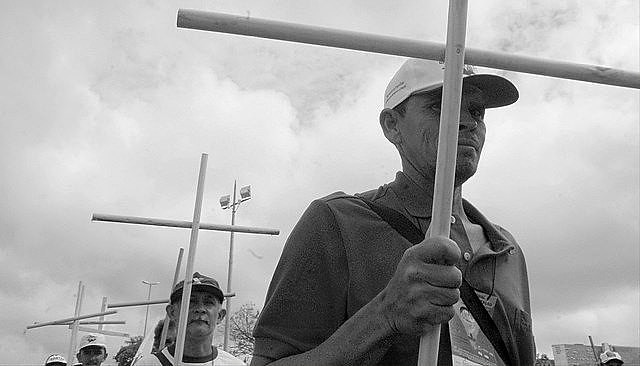While the Brazilian religious advocacy group Pastoral Land Commission (Comissão Pastoral da Terra – CPT) was planning the release of a report on the number of people murdered in rural conflicts in Brazil in 2017, another activist was found dead. Last Sunday (15), the body of quilombola leader Nazildo dos Santos Brito, 33, was found with gunshot wounds to the head and ribs in the community originating from a quilombo Remanescentes do Quilombo Turê III, on the border between the cities of Tomé-Açu and Acará, in the northern state of Pará. A quilombola is a resident of quilombos, settlements set up in Brazil’s rural areas, mostly by escaped enslaved people of African descent.
The police are investigating the case and suspect the crime was politically motivated. Brito had been receiving death threats for denouncing environmental crimes.
Deaths on the rise
The CPT data disclosed yesterday (16) show that the brutal reality of Brazil’s rural areas has become increasingly harsher since 2013, back when 34 murders were recorded. In four years, these figures have increased by 105%, reaching 70 executions in 2017 – a 15% increase over 2016.
These figures are likely to be even worse, as the deaths of 10 isolated indigenous people in Vale do Javari, state of Amazonas, in July and August 2017, have not been confirmed as murders by the prosecution office and the National Indian Foundation (Fundação Nacional do Índio – FUNAI), Brazil’s official agency responsible for policies regarding indigenous people.
CPT coordinator Ruben Siqueira points out violence is constant in Brazil’s rural areas, as the entity’s surveys have been showing since 1985.
The corporate offensive
Siqueira explains that the rising murder rate in Brazil’s rural areas as of 2013 is connected with the corporate offensive in Brazilian lands. “We see this as a new land rush, in which land is a means of production, a store of value, like wood, water, ore, agribusiness, expansion of land-based businesses. This has to do with the financial crisis that started in 2008 with the speculative bubble. Since then, the hegemonic capitalist sector, which is financial capital, is looking for backing, something that can support this international speculative game,” he analyzes.
The CPT has recorded the killing of people including landless rural workers, indigenous people, quilombolas, smallholders of public land claiming title (the so-called posseiros), fishers, and agrarian reform settlers. The state of Pará, in northern Brazil, is at the top of the list, with 21 people killed in 2017, followed by Rondônia, with 17, Bahia, with 10, and Mato Grosso, with 9 people murdered in land-related conflicts.
The CPT survey also draws attention to new mass killings that have happened last year. In 2017, there were four massacres with 28 deaths total, representing 40% of all murders recorded by the CPT. The crimes were committed in Colniza, Mato Grosso; Vilhena, Rondônia; Pau D’Arco, Pará; and Lençóis, Bahia.
While in 2016, for example, there were no land-conflict-related massacres in Brazil’s rural areas, Siqueira said the 2017 mass killing rate was the highest recorded by the CPT since 1987. The CPT classifies a massacre as a case where at least 3 people are killed in the same occasion and for the same reason.

2003-2017 Killings
Source: Dom Tomás Balduino Documentation Center – CPT
License to Kill
“The return and high incidence of massacres [in 2017], with 28 slaughtered people in four massacres, have to do with this atmosphere we’re experiencing in the country, where anything seems possible. Either the State is not there or it’s inducing a freedom, which is not really freedom, but rather a license to kill and do whatever they want,” Siqueira claims.
From 1985 to 2017, the CPT has recorded 1,438 cases of conflicts in Brazilian rural areas, with 1,904 victims. Only 113 – or 8% – of those cases have gone to trial.
Ruben Siqueira has also informed that the full report 2017 Conflicts in Brazil’s Rural Areas could not be released this week, as the International Day of Peasants’ Struggle is celebrated today (17), because the CPT’s servers were attacked by hackers at the end of last year. The Federal Police are investigating the case and the full report should be launched next month.




